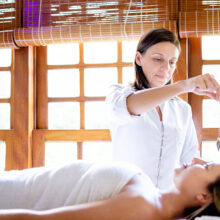The A to ZZZ’s of Setting Up Your Sleep Sanctuary
- Published: Thursday, March 10th 2016
- in Mindset
 Getting your ZZZ’s matters for multiple reasons and here’s a wakeup call: For many of us, good sleeping habits are lacking. For example, stats from the Centers for Disease Control and Prevention show that over one-quarter of the U.S. population occasionally does not get enough sleep, while almost 10 percent experiences chronic insomnia. So we spoke with Sheryl Brooks, R.N. and sleep specialist for Miraval Resort & Spa, about ways to create the ideal sleep sanctuary.
Getting your ZZZ’s matters for multiple reasons and here’s a wakeup call: For many of us, good sleeping habits are lacking. For example, stats from the Centers for Disease Control and Prevention show that over one-quarter of the U.S. population occasionally does not get enough sleep, while almost 10 percent experiences chronic insomnia. So we spoke with Sheryl Brooks, R.N. and sleep specialist for Miraval Resort & Spa, about ways to create the ideal sleep sanctuary.
“The benefits of creating a supportive sleep sanctuary are more nights of better sleep, which in turn supports a healthier, better functioning body and brain and promotes healthy aging,” says Sheryl. “For adults, the goal would be to get somewhere between 7-9 hours of sleep most nights. If that isn’t happening, I would recommend getting intentional about improving your sleeping habits.”
Forget counting sheep—try these ideas instead:
1. Remove anything from your bedroom that doesn’t support sleep or sex, says Sheryl. “Creating an atmosphere that promotes relaxation helps promote sleep because you are not reminded of what else you could be doing,” she offers. Those piles of laundry? That paperwork for tomorrow’s business meeting? Banish them from the room.
And if you truly can’t dedicate the entire room to sleep and sex, “make every effort to isolate the bed area from the rest of the room,” she continues. “The idea is to condition yourself to associate that space with sleep.”
2. Find some type of practice that will induce sleepiness. “When I work with guests and help them create a sleep plan, there is always a focus on creating a pre-sleep ritual, or sunset for themselves, which helps them put their mind and body activities away and promote sleepiness,” Sheryl reveals. “They only get into bed once they are sleepy.”
3. Cut out sensory stimulation as much as possible.
- The ideal sleep space should be as dark as possible; if you do prefer a bit of light in your room or you’re unable to achieve complete darkness, Sheryl suggests trying a sleep mask.
- Eliminate or block out intermittent noise as well. “For some, a whirring fan or a sleep noise machine is helpful. Others may require ear plugs,” she says.
4. A cool room (usually 68 degrees or less) but a warm bed helps most people, Sheryl also notes.
5. A relaxing scent that is reserved only for the bedroom further conditions you to expect sleep in that space, she adds.
Your Wellness Tip To-Go:
Interested in achieving better sleep habits? Find out more about Sheryl’s group and private workshops, including “Are You Sleeping?” and “Get a Better Night’s Sleep,” at Miraval.




